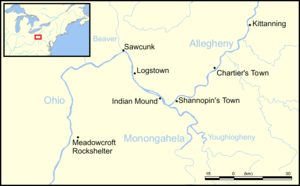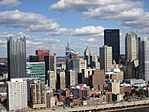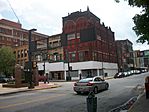Western Pennsylvania facts for kids
Quick facts for kids
Western Pennsylvania
|
|
|---|---|

Indigenous American villages were located throughout Western Pennsylvania. Kittanning still uses its Indigenous name, while the town of Sawcunk lies on the site of present-day Rochester, Pennsylvania.
|
|
| Country | United States |
| Commonwealth | Pennsylvania |
| Largest city | Pittsburgh |
| Other cities |
List
|
| Area | |
| • Total | 20,363 sq mi (52,740 km2) |
| • Land | 19,412 sq mi (50,280 km2) |
| • Water | 951 sq mi (2,460 km2) 4.67% |
| Population
(2020 Census)
|
|
| • Total | 3,753,944 |
| • Density | 193.38/sq mi (74.66/km2) |
| Time zone | UTC-5 (ET) |
| • Summer (DST) | UTC-4 (EDT) |
Western Pennsylvania is a special part of the Commonwealth of Pennsylvania. It covers the western third of the state. Pittsburgh is the biggest city here, with about 2.4 million people living in its wider area. It's the main center for business and culture. Other important cities include Erie, Altoona, and Johnstown. In 2010, almost 4 million people lived in Western Pennsylvania.
Even though Pennsylvania doesn't officially name Western Pennsylvania as a region, it has always felt different. This is because it's far from Philadelphia, where Pennsylvania was first settled. Also, the Appalachian Mountains separate it from the eastern part of the state. This strong local identity is even shown by the state supreme court holding meetings in Pittsburgh, as well as in Harrisburg and Philadelphia.
Contents
Counties of Western Pennsylvania
For a long time, experts have defined Western Pennsylvania as the twenty-six counties west of the Appalachian Divide. This imaginary line runs from McKean County in the north down to Bedford County in the south.
Here are those counties in alphabetical order:
Geography and Rivers
Western Pennsylvania is a large area with unique land features and a strong history of industry. It's the part of the state west of the Appalachian mountains. Its rivers flow into the Mississippi River system.
Major Rivers and Their Meeting Point
The two biggest rivers here are the Allegheny River and the Monongahela River. The Allegheny flows south from New York, and the Monongahela flows north from West Virginia. They meet in Downtown Pittsburgh to form the Ohio River. From there, the Ohio River flows about 981 kilometers (610 miles) southwest to the Mississippi River.
This meeting point of the Allegheny and Monongahela rivers has always been very important. People called it the Forks of the Ohio, Fort Duquesne, Fort Pitt, and the Golden Triangle. Today, it's Point State Park. Amazingly, a blockhouse from the original Fort Pitt, built in 1764, is still standing there. It's one of the oldest buildings in the region!
Other Important Rivers
Other notable rivers include the Youghiogheny River, which flows north from West Virginia and Maryland to join the Monongahela. It was an early path into Western Pennsylvania. French Creek was a key route between Lake Erie and the Allegheny River for Native Americans and early explorers. The small Oil Creek is famous because the first oil well in the United States was drilled in its area.
Mountains and Plateaus
The highest point in Pennsylvania, Mount Davis, is 3,213 feet (979 meters) tall. It's located in Somerset County, about 100 miles (160 km) east of the state's southwestern corner. This is where the Appalachian Mountains enter Pennsylvania from the south.
West and north of Mount Davis is the Allegheny Plateau. This area has been so worn down by nature that it looks like endless high hills and deep valleys. While the peaks aren't as tall as some other mountains, they cover a huge area. This made it very hard to travel overland from the coast in the past.
Northwestern Pennsylvania's Unique Features
The city of Erie is the main business and cultural center of Northwestern Pennsylvania. This area had about 938,516 people in 2015. Most counties had stable populations, with Butler showing some growth.
Northwestern Pennsylvania is also home to the Allegheny National Forest. This region is important for Pennsylvania's oil and gas industry.
Colleges and Universities
Western Pennsylvania has many places where you can go to college or university. Here are some of them:
- Allegheny College
- The Art Institute of Pittsburgh
- Community College of Allegheny County (several campuses)
- Community College of Beaver County
- Butler County Community College (several campuses)
- California University of Pennsylvania
- Carlow University
- Carnegie Mellon University
- Chatham University
- Clarion University of Pennsylvania
- Duquesne University
- Edinboro University of Pennsylvania
- Gannon University
- Geneva College
- Grove City College
- Indiana University of Pennsylvania (several branch campuses)
- LaRoche College
- Lake Erie College of Osteopathic Medicine
- Mercyhurst University
- Mount Aloysius College
- Penn Highlands Community College
- Pennsylvania State University (several branch campuses)
- Point Park University
- Robert Morris University
- Saint Francis University
- Saint Vincent College
- Seton Hill University
- Slippery Rock University of Pennsylvania
- Thiel College
- University of Pittsburgh (several campuses)
- Vincentian Academy
- Washington and Jefferson College
- Waynesburg University
- Westminster College
- Westmoreland County Community College
What Makes Western Pennsylvania Special
Western Pennsylvania is unique for several reasons:
Overcoming Travel Challenges
Getting to Western Pennsylvania from the east used to be very hard. Travelers faced many miles of mountains and thick forests. Early routes went south through Maryland and Virginia before turning back into Pennsylvania. Later, canals and the Pennsylvania Railroad made travel easier. The Pennsylvania Turnpike, one of the first modern highways, also greatly improved access.
Economic History and Resources
At first, it was hard to sell goods from Western Pennsylvania because shipping costs were so high. This led to the Whiskey Rebellion, where farmers protested a tax on whiskey. This event was a big challenge for the new American government. Later, the Ohio River became a key trade route, making Pittsburgh a major center for barges and steamboats. Today, the Port of Pittsburgh still ships a lot of coal by river.
Farmers in the area focused on raising animals and dairy, as the hilly land wasn't great for many crops. This might have even helped start the sauce industry, with the famous H.J. Heinz Company beginning here.
The region had huge amounts of soft coal. This coal was used in iron factories. But it was Andrew Carnegie who realized Western Pennsylvania was perfect for a large steel industry. This made Pittsburgh famous for steel. The area also had big glass, pottery, and brickmaking industries, using local coal, sand, and clay. By the 1920s, the local glass industry made over 80% of the nation's glass!
When the American steel industry later declined, it was a tough time for the region. This period is sometimes called the Rust Belt era.
Other Important Resources
Western Pennsylvania was also home to the world's first oil well, drilled in Titusville. This started the US petroleum industry. Large areas of forest were also cut down, but then replanted under Gifford Pinchot. This was the first big government effort to manage timber in the USA.
The region's large deer population supports a popular "Pennsylvania deer-hunting" tradition. The first day of deer-hunting season is almost like a holiday in many parts of the state!
Pittsburgh's Revival
Since the 1950s, Pittsburgh and its surrounding area have seen a big improvement. There are more cultural places, and pollution has been greatly reduced. The Golden Triangle area of Downtown Pittsburgh used to be so hazy from industry that drivers needed headlights in the middle of the day! Now, it's much cleaner and more pleasant.
Unique Local Culture
Western Pennsylvania has its own unique way of speaking, called "Pittsburghese" or Pittsburgh English. People sometimes call it the "yinzer" dialect because of the word "yins" (or "yunz," "yinz," "youns"), which means "you all" or "y'all." This probably comes from early settlers from Scotland and Ireland. Also, people in Western Pennsylvania call soft drinks "pop," while people in the eastern part of the state usually say "soda."
The Erie Triangle
The Erie Triangle and the city of Erie give Pennsylvania a port on the Great Lakes. This area is special because it feels more connected to western New York than to other parts of Western Pennsylvania. This is because it's part of the Great Lakes region, not the Appalachian mountains. Erie is known for growing grapes and other fruits because Lake Erie helps keep the weather mild. In winter, though, the area often gets a lot of "lake-effect" snow! There are also small fishing businesses and many places to catch fish like yellow perch and walleye.
Flight 93 National Memorial
In Stonycreek Township is the Flight 93 National Memorial. This is the crash site of United Airlines Flight 93 from 9/11 in 2001. The passengers bravely fought back against the hijackers. It's a place where people leave handmade tributes. It's interesting that this site is close to other historical battle locations in Western Pennsylvania, like Fort Duquesne and the area of the Whiskey Rebellion. This is because all these places were on important routes from the east to the west.
Sports Teams
Pittsburgh is home to three major professional sports teams:
- The Pittsburgh Steelers (football, National Football League)
- The Pittsburgh Pirates (baseball, Major League Baseball)
- The Pittsburgh Penguins (hockey, National Hockey League)
The Pittsburgh Panthers are a college team that plays in NCAA Division I. Erie and Johnstown also have junior ice hockey teams. The Erie Otters play in the Ontario Hockey League, and the Johnstown Tomahawks play in the North American Hockey League. There's also a professional independent baseball team in Washington, the Washington Wild Things, who play in the Frontier League.





